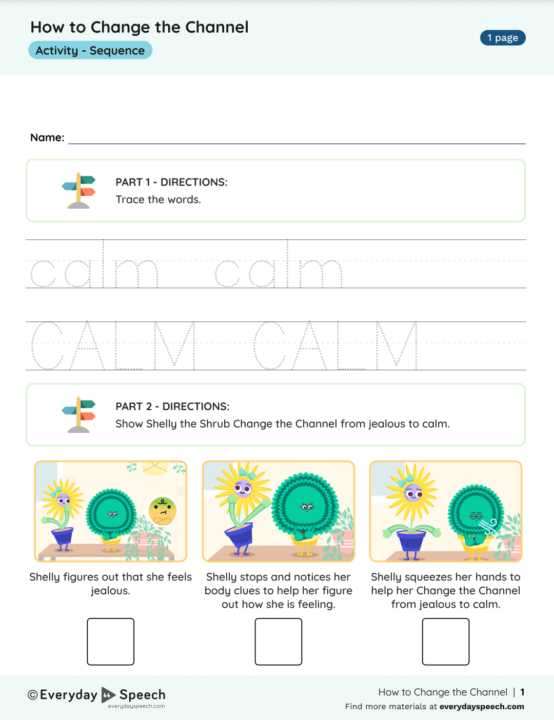
Today’s blog post is dedicated to empowering professionals with effective, no-prep activity ideas centered around “Preschool Calming Strategies Lesson”. This guide is designed to offer simple yet impactful techniques to help young learners master the art of calming down, an essential skill for their academic and social success.
Understanding the Importance of Calming Strategies
Before diving into the lesson plan, it’s crucial to understand why calming strategies are indispensable in a preschool setting. Young children are in the initial stages of emotional development and often find it challenging to manage strong emotions. Teaching them how to calm down not only aids in immediate stress relief but also lays the groundwork for healthy emotional regulation skills that will benefit them throughout their lives.
Preschool Calming Strategies Lesson Plan: Key Elements
Our lesson plan is structured to be both practical and engaging, ensuring that children can grasp and apply the concepts with ease. We have focused on activities that require no preparation, making it easier for busy speech-language pathologists and educators to implement them in any setting.
1. Introduction to Calming Techniques
Objective: To introduce preschoolers to the concept of feeling calm and understanding when and why they might need to use calming strategies.
Activity: Feeling Faces
- Description: Use pictures of different emotions and ask children to identify and name the feelings. Discuss situations that might cause these emotions and emphasize the importance of feeling calm.
- Keywords: Emotions, calm, identify, discuss.
2. Deep Breathing Exercises
Objective: To teach children how to use deep breathing as a primary technique to calm down.
Activity: Balloon Breathing
- Description: Instruct children to imagine their belly is a balloon that inflates as they breathe in through their nose and deflates as they breathe out through their mouth. Practice this exercise several times.
- Keywords: Deep breathing, balloon, inhale, exhale.
3. Sensory Activities
Objective: To use sensory activities as a means to achieve calmness in preschoolers.
Activity: Calm Down Jar
- Description: Show a calm down jar (a container filled with water, glitter, and glue). Shake the jar and let children watch the glitter settle. Explain how their feelings can also settle down like the glitter.
- Keywords: Sensory, calm down jar, watch, feelings.
4. Mindfulness and Relaxation
Objective: To introduce basic mindfulness and relaxation techniques to help children calm down.
Activity: Quiet Time
- Description: Encourage children to sit quietly, close their eyes, and focus on a peaceful scene or thought. Use a soft bell to signal the start and end of quiet time.
- Keywords: Mindfulness, relaxation, quiet, focus.
5. Positive Visualization
Objective: To teach children how to use their imagination to visualize calming scenes or experiences.
Activity: Happy Place
- Description: Guide children through imagining a place where they feel happy and calm. Ask them to describe what they see, hear, and feel in their happy place.
- Keywords: Visualization, imagination, happy place, describe.
Implementing the Lesson Plan: Tips for Success
- Adaptability: Flexibly adjust the activities to suit the needs and interests of your preschoolers.
- Consistency: Regular practice of these strategies will help children internalize and utilize them effectively.
- Parent Involvement: Share these strategies with parents so they can reinforce the skills at home.
Everyday Speech offers hundreds of materials to help teach calming and self-regulation skills. This “How to Change the Channel” worksheet accompanies our video lesson teaching kids to “change the channel on big feelings” by using calm down strategies. It would be a great addition to any of the above introduction activities.

Unlock your free material for this lesson by signing up for your free trial today – no credit card required!
Get your free materials here!
Instant access to thousands of no-prep social skills activities, over 800+ video lessons, and engaging games designed to enhance learning and development.
Conclusion
Teaching calming strategies to preschoolers is a valuable aspect of their emotional and social development. By integrating these simple, no-prep activities into your lesson plans, you can equip young learners with the tools they need to manage their emotions effectively.
Sample Video
Students learn best from watching real students their own age model skills. Try out this sample video lesson. We offer our entire Social-Emotional Learning platform free for 14 days here!
Related Blog Posts:
Teaching Problem-Solving Skills through Social-Emotional Learning
Teaching Preschoolers Patience with Waiting Strategies
How to Support SEL for Preschoolers

